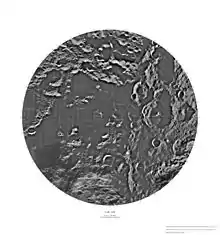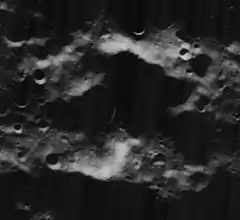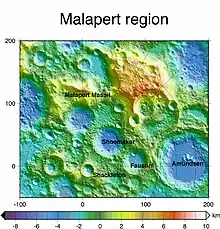Malapert (crater)
Malapert is a lunar impact crater that lies near the southern limb of the Moon. From the Earth this formation is viewed from the side, limiting the amount of detail that can be seen. The crater is also illuminated at very low angles, so that parts of the interior remain in almost constant darkness. The nearest craters of note are Cabeus to the west, and Shoemaker to the south-southeast and nearer to the south pole of the Moon.

.tiff.jpg.webp)
 Lunar Orbiter 4 image with north at top. Malapert Mountain is the bright peak near bottom center. | |
| Coordinates | 84.9°S 12.9°E |
|---|---|
| Diameter | 69 km |
| Depth | Unknown |
| Colongitude | 0° at sunrise |
| Eponym | Charles Malapert[1] |
The rim of Malapert forms an irregular ring of peaks around the interior floor. The western side of the rim is overlain by what appear to be impact craters. There are also small craters overlying the southeastern rim. Much of the interior and details of the rim remain hidden by shadows.
The southwestern part of the rim forms part of a 5-km-high rise in the surface that has been unofficially designated Malapert Mountain. This ridge appears wider along a line running roughly east–west, although details of the back side are hidden by shadows. The peak of this ridge lies almost exactly along 0° longitude, and it has the unusual attribute of lying within sight of both the Earth and the crater Shackleton at the south pole.
Mission concepts and plans
Due to the location of Malapert Mountain, it has been proposed as the site of a transmitter for an expedition to the south lunar pole.[2] The back side of this ridge also lies within the radio shadow for transmissions from the Earth, and it has been suggested as a site for a radio telescope because the radio noise from our planet would be blocked.
In July 2013, private company Moon Express released details of a mission they are planning for no earlier than 2018. The mission will land two telescopes on the Moon, with the preferred location of Malapert crater, to take advantage of the benefits previously identified by David.[2] The equipment would include both a 2 metres (6 ft 7 in) radio telescope as well as an optical telescope.[3] This is the specific mission design of the mission first announced publicly the previous year, in collaboration with the International Lunar Observatory Association (ILOA).[4]
Satellite craters

By convention these features are identified on lunar maps by placing the letter on the side of the crater midpoint that is closest to Malapert.
| Malapert | Latitude | Longitude | Diameter |
|---|---|---|---|
| A | 80.4° S | 3.4° W | 24 km |
| B | 79.1° S | 2.4° W | 37 km |
| C | 81.5° S | 10.5° E | 40 km |
| E | 84.3° S | 21.2° E | 17 km |
| F | 81.5° S | 14.9° E | 11 km |
| K | 78.8° S | 6.8° E | 36 km |
Images
At a Space Resources Roundtable co-sponsored by the Lunar and Planetary Institute a presentation by B. L. Cooper underscored the difficulty of imaging terrain illuminated by high-incidence-angle light.[5] Nonetheless, the images in her presentation show the Malapert Mountain area well.
In popular culture
In the 1970s British science fiction series Space: 1999, the location of Moonbase Alpha is Malapert Crater.[6]
The International Lunar Observatory (ILO-1) is a lunar-based optical telescope that will be launched after 2022, and will land on the Malapert Mountain ridge.[7][8]
See also
References
- Malapert, Gazetteer of Planetary Nomenclature, International Astronomical Union (IAU) Working Group for Planetary System Nomenclature (WGPSN)
- David, Leonard (March 26, 2002). "The Moon's Malapert Mountain Seen As Ideal Site for Lunar Lab". space.com. Archived from the original on April 20, 2007. Retrieved 2015-07-09.
- Mann, Adam (2013-07-18). "The Private Plan to Put a Telescope on the Moon". Wired. Retrieved 2013-07-21.
- Sutherland, Paul. "Moon Express to fly lunar telescope". Sen.com. Archived from the original on 14 July 2018. Retrieved 19 August 2012.
- Cooper, B. L. (2006). "Craters and Channels on Malapert Mountain in the Lunar South Pole Region: Challenges Associated with High-Incidence-Angle Imagery" (PDF). Retrieved 2007-08-28.
- Moonbase Alpha Operational Guide http://catacombs.space1999.net/main/maog/maog4.html. Retrieved 2015-03-21.
- Internatioinal Lunar Observatory to offer a new astrophysical perspective. Spaceflight Insider. Tonasz Nowakowski. 12 August 2017.
- International Lunar Observatory to be Established at Moon's South Pole in 2019 Archived 2018-03-20 at the Wayback Machine. Moon Express- Press Release. 21 July 2017.
- Burton L. Sharpe & David G. Schrunk. "Malapert Mountain Revisited". Proceedings of Space 2002: The Eighth International Conference And Exposition On Engineering, Construction, Operations, And Business In Space. pp. 129–135.
- Andersson, L. E.; Whitaker, E. A. (1982). NASA Catalogue of Lunar Nomenclature. NASA RP-1097.
- Blue, Jennifer (July 25, 2007). "Gazetteer of Planetary Nomenclature". USGS. Retrieved 2007-08-05.
- Bussey, B.; Spudis, P. (2004). The Clementine Atlas of the Moon. New York: Cambridge University Press. ISBN 978-0-521-81528-4.
- Cocks, Elijah E.; Cocks, Josiah C. (1995). Who's Who on the Moon: A Biographical Dictionary of Lunar Nomenclature. Tudor Publishers. ISBN 978-0-936389-27-1.
- McDowell, Jonathan (July 15, 2007). "Lunar Nomenclature". Jonathan's Space Report. Retrieved 2007-10-24.
- Menzel, D. H.; Minnaert, M.; Levin, B.; Dollfus, A.; Bell, B. (1971). "Report on Lunar Nomenclature by the Working Group of Commission 17 of the IAU". Space Science Reviews. 12 (2): 136–186. Bibcode:1971SSRv...12..136M. doi:10.1007/BF00171763. S2CID 122125855.
- Moore, Patrick (2001). On the Moon. Sterling Publishing Co. ISBN 978-0-304-35469-6.
- Price, Fred W. (1988). The Moon Observer's Handbook. Cambridge University Press. ISBN 978-0-521-33500-3.
- Rükl, Antonín (1990). Atlas of the Moon. Kalmbach Books. ISBN 978-0-913135-17-4.
- Webb, Rev. T. W. (1962). Celestial Objects for Common Telescopes (6th revised ed.). Dover. ISBN 978-0-486-20917-3.
- Whitaker, Ewen A. (1999). Mapping and Naming the Moon. Cambridge University Press. ISBN 978-0-521-62248-6.
- Wlasuk, Peter T. (2000). Observing the Moon. Springer. ISBN 978-1-85233-193-1.